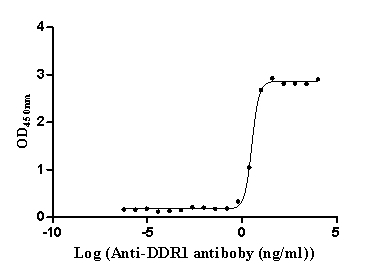Recombinant Human Ubiquitin-protein ligase E3B (UBE3B), partial
-
中文名稱:人UBE3B重組蛋白
-
貨號:CSB-YP767194HU
-
規(guī)格:
-
來源:Yeast
-
其他:
-
中文名稱:人UBE3B重組蛋白
-
貨號:CSB-EP767194HU
-
規(guī)格:
-
來源:E.coli
-
其他:
-
中文名稱:人UBE3B重組蛋白
-
貨號:CSB-EP767194HU-B
-
規(guī)格:
-
來源:E.coli
-
共軛:Avi-tag Biotinylated
E. coli biotin ligase (BirA) is highly specific in covalently attaching biotin to the 15 amino acid AviTag peptide. This recombinant protein was biotinylated in vivo by AviTag-BirA technology, which method is BriA catalyzes amide linkage between the biotin and the specific lysine of the AviTag.
-
其他:
-
中文名稱:人UBE3B重組蛋白
-
貨號:CSB-BP767194HU
-
規(guī)格:
-
來源:Baculovirus
-
其他:
-
中文名稱:人UBE3B重組蛋白
-
貨號:CSB-MP767194HU
-
規(guī)格:
-
來源:Mammalian cell
-
其他:
產(chǎn)品詳情
-
純度:>85% (SDS-PAGE)
-
基因名:
-
Uniprot No.:
-
別名:UBE3B; Ubiquitin-protein ligase E3B; EC 2.3.2.26; HECT-type ubiquitin transferase E3B
-
種屬:Homo sapiens (Human)
-
蛋白長度:Partial
-
蛋白標(biāo)簽:Tag?type?will?be?determined?during?the?manufacturing?process.
The tag type will be determined during production process. If you have specified tag type, please tell us and we will develop the specified tag preferentially. -
產(chǎn)品提供形式:Lyophilized powder
Note: We will preferentially ship the format that we have in stock, however, if you have any special requirement for the format, please remark your requirement when placing the order, we will prepare according to your demand. -
復(fù)溶:We recommend that this vial be briefly centrifuged prior to opening to bring the contents to the bottom. Please reconstitute protein in deionized sterile water to a concentration of 0.1-1.0 mg/mL.We recommend to add 5-50% of glycerol (final concentration) and aliquot for long-term storage at -20℃/-80℃. Our default final concentration of glycerol is 50%. Customers could use it as reference.
-
儲存條件:Store at -20°C/-80°C upon receipt, aliquoting is necessary for mutiple use. Avoid repeated freeze-thaw cycles.
-
保質(zhì)期:The shelf life is related to many factors, storage state, buffer ingredients, storage temperature and the stability of the protein itself.
Generally, the shelf life of liquid form is 6 months at -20°C/-80°C. The shelf life of lyophilized form is 12 months at -20°C/-80°C. -
貨期:Delivery time may differ from different purchasing way or location, please kindly consult your local distributors for specific delivery time.Note: All of our proteins are default shipped with normal blue ice packs, if you request to ship with dry ice, please communicate with us in advance and extra fees will be charged.
-
注意事項(xiàng):Repeated freezing and thawing is not recommended. Store working aliquots at 4°C for up to one week.
-
Datasheet :Please contact us to get it.
相關(guān)產(chǎn)品
靶點(diǎn)詳情
-
功能:E3 ubiquitin-protein ligase which accepts ubiquitin from an E2 ubiquitin-conjugating enzyme in the form of a thioester and then directly transfers the ubiquitin to targeted substrates.
-
基因功能參考文獻(xiàn):
- we present four patients with five novel UBE3B mutations and propose the inclusion of clinical features to the characteristics of Kaufman oculocerebrofacial syndrome, including prominence of the cheeks and limb anomalies. PMID: 29160006
- studies demonstrate that UBE3B is an E3 ubiquitin ligase and reveal that the enzyme is regulated by calmodulin. Furthermore, the modulation of UBE3B via calmodulin and calcium implicates a role for calcium signaling in mitochondrial protein ubiquitylation, protein turnover, and disease PMID: 28003368
- Sanger sequencing was negative for the DOORS syndrome gene TBC1D24 but exome sequencing identified a homozygous deletion in UBE3B (NM_183415:c.3139_3141del, p.1047_1047del) located within the terminal portion of the HECT domain PMID: 28003643
- The E3 ligase activity of UBE3B is regulated by its interaction with calmodulin via the N-terminal IQ domain. PMID: 28003368
- UBE3B encodes a widely expressed protein ubiquitin ligase E3B, which, when mutated in both alleles, causes Kaufman oculocerebrofacial syndrome. PMID: 25691420
- UBE3B mutations cause a clinically recognizable and possibly underdiagnosed syndrome named the Kaufman oculocerebrofacial syndrome PMID: 24615390
- data provide evidence that Kaufman oculocerebrofacial syndrome is caused by UBE3B loss of function, and further demonstrate the impact of misregulation of protein ubiquitination on development and growth. PMID: 23687348
- Our data reveal the pleiotropic effects of UBE3B deficiency and reinforce the physiological importance of ubiquitination in neuronal development and function in mammals. PMID: 23200864
- UBE3B is a novel E3 ligase, with a HECT-domain which constitutes the active site for ubiquitin transfer PMID: 12837265
- the apparent occurrence of an unusual TG 3' splice site in intron 25 is discussed PMID: 17672918
顯示更多
收起更多
-
相關(guān)疾?。?/div>Kaufman oculocerebrofacial syndrome (KOS)組織特異性:Widely expressed.數(shù)據(jù)庫鏈接:
Most popular with customers
-
Recombinant Mouse Prolactin receptor (Prlr), partial (Active)
Express system: Mammalian cell
Species: Mus musculus (Mouse)
-
Recombinant Human Zymogen granule protein 16 homolog B (ZG16B) (Active)
Express system: Mammalian cell
Species: Homo sapiens (Human)
-
Recombinant Human Epithelial discoidin domain-containing receptor 1 (DDR1), partial (Active)
Express system: Mammalian cell
Species: Homo sapiens (Human)
-
Recombinant Macaca fascicularis Trophoblast glycoprotein (TPBG), partial (Active)
Express system: Mammalian cell
Species: Macaca fascicularis (Crab-eating macaque) (Cynomolgus monkey)
-
Recombinant Human Interleukin-2 receptor subunit alpha (IL2RA), partial (Active)
Express system: Mammalian cell
Species: Homo sapiens (Human)
-
Recombinant Human Oncostatin-M (OSM), partial (Active)
Express system: Mammalian cell
Species: Homo sapiens (Human)
















